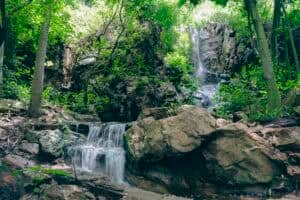Historic landmarks were among the significant casualties in fires now said to have been caused by deliberate arson. Investigations are continuing.

Up to 40 fires raged in the Table Mountain National Park (TMNP) from Sunday 18 April to Monday 19 April, investigation findings revealed at a media briefing on Thursday.
Fire investigator Rob Erasmus explained in detail that responses to quell the fire were conducted quickly, but due to humidity levels being below 20%, combined with an unseasonably warm day, any type of vegetation in the path of the fire acted as kindling to allow it to spread faster than firefighters could keep up.
ALSO READ: How climate change helped fuel Cape Town fires
Fire movements

Smoke on Devil’s Peak in Cape Town on Monday, 19 April 2021. Picture: Twitter/@TableMountainNP
To make matters more challenging, a change in wind speed and direction took place roughly 30 minutes after the first fire was reported to authorities.
“Each ember started a new fire. We’re talking 20 to 40 fires starting. Some amalgamated, others changed to make their own fire paths,” he said.
After progressing in a south-easterly direction, the fire moved with “rapid speed” towards Rhodes Memorial. He said within the space of 10 minutes, patrons at the Rhodes Memorial Tea Garden went from enjoying a late breakfast to being evacuated.
ALSO READ: Five things you need to know about the Cape Town fires
The fire then made its way across the N3 and continued to spread until around 11pm, when the wind direction changed again, pushing the blaze up Devil’s Peak and in the direction of the University of Cape Town, before burning back towards the city at the front of Devil’s Peak.

Working on Fire teams make their way to fires in the Table Mountain National Park on 18 April 2021. Photo: Twitter/@wo_fire
On Sunday night around 8.30pm, reports of another fire were received in the Vredehoek area. Authorities found three separate fires burning in the area, but it was found the distance between the morning and evening fires was too great for the two to have been connected.
On the Monday morning, fires raged in Vredehoek and were only contained by mid-afternoon.
ALSO READ: Cape Town fires thrust homeless into the spotlight
Not natural or accidental

An aerial view of Cape Town after the fires started on Sunday 18 April 2021. Picture: Facebook/Friends of Table Mountain
Natural causes of the fires were ruled out due to there being no lightning in the area, no rockfalls and no spontaneously combusting vegetation.
A ditch was found close to where the morning fires started, but no evidence of human occupation was found. CCTV footage confirmed that from 6am no signs of human activity were found on the urban edge of the TMNP.
This also ruled out the fires being started accidentally or due to negligence.
ALSO READ: Table Mountain fires were deliberate arson, investigations reveal
Firebreaks were in place

To make matters more challenging, a change in wind speed and direction took place roughly 30 minutes after the first fire was reported. Picture: Twitter/@TableMountainNP
Erasmus assured that firebreaks were in place and were regularly maintained.
“We have proof they were replaced and maintained,” he said.
Pine trees
Pine trees make fine kindling for fires, but Erasmus said these trees, although slowly being eradicated in some areas, would not be completely removed.
This is because the trees form “part of the park’s heritage”, as per UCT’s Heritage Park Framework.
However, ongoing efforts are in place to remove a number of exotic species such as bluegum and pine trees.
Fuel loads

Table Mountain National Park’s mountains are steadily being cleared of invasive plant species. Pictured is an indigenous wit steekbos plant. Picture: Nica Richards
Fuel loads, which come in the form of alien invasive species or fynbos, are regarded by some as a dangerous catalyst that could increase the frequency of fires at TMNP.
However, alternative methods are being looked into, with some vegetation dangerously close to homes and the park’s urban edge.
Mostert’s Mill couldn’t be saved

What remained of Mostert’s Mill. Picture: Facebook/Friends of Rhodes Memorial
Saving the historic Mostert’s Mill was not a practical option at the time.
ALSO READ: Counting the historical cost of Cape Town’s fires
Erasmus said the mill burnt down very quickly due to embers landing on the roof of the structure. The loss, although regrettable, was not able to be avoided.
Trees at UCT

A firefighter battles a blaze that destroyed the nearly 200-year-old Jagger Library on the University of Cape Town campus on 18 April 2021. Picture: EPA-EFE/Nic Bothma
UCT’s campus has thrived as a mini forest for many years without incident and, until the most recent fires, this was never a problem.
However, because of low humidity rates, any ember flung into the air was likely to cause a fire.
Erasmus explained that when the fire spread to UCT, thick smoke was observed. Within this smoke “hundreds if not thousands” of embers were floating around, sparking new fires across the campus at the same time.
“A lot of the fires were not observed initially because of smoke.”






